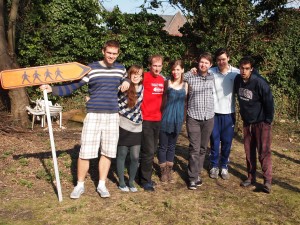We communicate all the time, especially online and it has already been mentioned once but will be mentioned again that there seems to be lack of interest in AEGEE about how we choose to handle cases especially such as PR, and e-mailing each other. Being a member of the Sports Working Group board, I have experienced myself that people feel overwhelmed with all the mail coming in to AEGEE members’ accounts day in and day out – leaving me to wonder, have the communication guidelines worked at all?
Comité Directeur (CD) members of at least “three generations” have been trying to improve the structure of communication within AEGEE especially with a focus on Facebook and the different AEGEE lists. Michael Makowiecki started working on the communication guidelines back when he was a CD member (Communications Director), but that how-to-communicate manual was not released until recently after hard work from now already former Internal Relations Director Jüri Kirpu as well as Public Relations Committee (PRC) members such as Michael Makowiecki and Reká Salamon to name a few. The AEGEEan had a talk with Jüri and Michael to find out the story as well as the intention behind the communication guidelines.
First of all, why did you see the need to update the communication guidelines?
Jüri: The way in which we communicate in AEGEE is very chaotic and the need for a communication policy, or in our case the Communication Guidelines (CG), is of high importance because, let’s face it, we cannot follow rules if there aren’t any. Michael created the version 0.9, but it was never published. Lots of things had changed to how they were a year before, for example that the creation of new committees and working groups had been put into practice, which again changed our structure of communication. For this reason, a need arose to compile an updated version of the guidelines.
Michael: Since the first version was drafted, a lot of things started to develop and change in the AEGEE communication channels, for example the Forum appeared. Also a reform of the communication channels was taking place, so I couldn’t finalise and publish the Communication Guidelines until this process had ended, but as many open questions remained, the task to make the document its final version was moved to my successor.
What have you changed?
Jüri: Many things. Although the current CG was compiled on the basis of version 0.9, the exact usage of lists was included, a list with the European level bodies was attached and many bulk texts from the previous version were re-written, so that it would be very understandable. The cherry on top was the design, which was different from the previous, and after a long process of getting comments and suggestions it bonded everything together in an extremely nice shape.
Michael: Many bigger and smaller things were changed or added. This mainly applies to a better description of mailing lists, the usage of the Forum and also a template for board change announcements, which was not in place in the previous version.
What are some of the most important parts of the communication guidelines?
Jüri: Everything. What is the most important part of a motor? This would be a question that amounts to the same thing, since the guidelines went through a round of comments from the Comité Directeur, then suggestions from the PRC, the Network had a chance to pass suggestions and criticism to me personally after it was sent to ANNOUNCE-L, and all of it was finished off by a Progress Meeting during the Agora, where Michael and I presented the CG.
Michael: It is difficult to choose one part as the most important or prominent one, but for me the clear definition of our communication channels is the key element of the Communication Guidelines. Following these will make the way in which we exchange information within the organisation more reliable and structured.
 It seems that the majority are still not following the guidelines, why is that the case?
It seems that the majority are still not following the guidelines, why is that the case?
Michael: In the first place it may be difficult to understand why we need such a document, as we are used to a very informal way of exchanging information in AEGEE. Nowadays it is getting even more informal, as major parts of it have simply been shifted to Facebook. People may find it difficult to understand why they should first check some document before actually writing a message. Moreover they already have their habits and common behaviour, so they might not see the need to change this. It is definitely a big challenge to make the bigger picture more understandable and to explain what kind of benefits we will all get from following the Guidelines.
Jüri: Well, this is one of the general problems that we are facing, because roughly only 10% of members actually view what is being sent to the lists. Also there are alternative ways of how information is spread to our members, there is always the Network Commission, the following of our social media channels or simple word to mouth, which usually travels among friends. Information quite often travels in an incoherent way, which is why we would not be facing these problems of “How we should communicate?” if at least all the board members in our Network followed the announcements sent via ANNOUNCE-L.
So if you are having difficulties with communication within your board, local, project team or simply in general, then have a look at the Communication Guidelines that the PRC worked hard on to finish. From Facebook to AEGEE lists to general explanation about the working groups and more, the PRC has really made a great effort to cover whatever area in AEGEE might need improvement when it comes to communication. Maybe you should ask yourself, “how do I/we communicate?” and then head to the intranet of AEGEE to download the CG and see if your answer is in accordance with what the PRC suggests is the best way to communicate.
Written by Patricia Anthony, AEGEE-København


1 comment for “How should we communicate?”